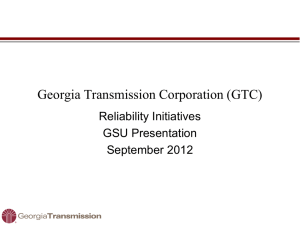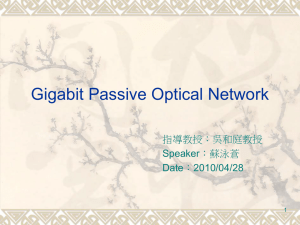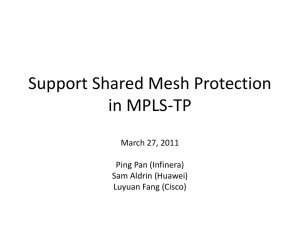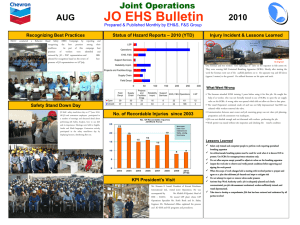PPT - University of California, Irvine
advertisement
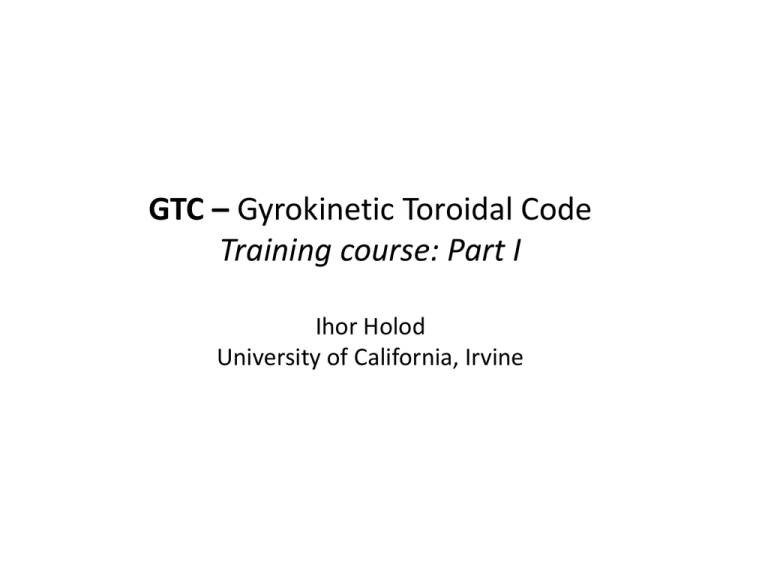
GTC – Gyrokinetic Toroidal Code Training course: Part I Ihor Holod University of California, Irvine Outline • Introduction • Gyrokinetic approach • GK equations of motion. GK Poisson’s equation. Delta-f method • Fluid-kinetic hybrid electron model: continuity equation, Ampere’s law, drift-kinetic equation • Tokamak geometry. Magnetic coordinates • Particle-in-cell approach. General structure of GTC. Grid. Parallel computing. • Setup and loading March 5-7, 2011 GTC Training Course - PKU 2 Introduction • Gryrokinetic simulations – important tool to study turbulence in magnetically confined plasma • Main target – low frequency microinstabilities • Source of free energy is needed to drive instabilities in plasma • Pressure gradient of ions, electrons or fast (energetic) particles • Ion temperature gradient mode (ITG) • Trapped electron mode (TEM) • Electron-temperature gradient mode (ETG) • Energetic particle mode (EPM) March 5-7, 2011 GTC Training Course - PKU 3 Gyrokinetic approach • Main advantage: gyroaveraging reduces dimensionality of particle dynamics from 6 to 5 [Hahm et al. PoF’88] • Gyrokinetic ordering: • Frequency smaller than gyrofrequency • Small fluctuation amplitude e B f ~ ~ ~ ~ 1 T B F • Additionally k s ~ 1 k|| k ~ 1 • Magnetic field inhomogeneity is small: March 5-7, 2011 GTC Training Course - PKU ln B ~ B 1 4 Charged particle motion in constant uniform magnetic filed March 5-7, 2011 GTC Training Course - PKU 5 Guiding center motion in the inhomogeneous magnetic filed dv|| dX ˆ ˆ v||b 0 v d b 0 B0 dt dt m • Magnetic drift velocity v d vc v g d 0 dt • Magnetic curvature drift vc v||2 bˆ 0 • Magnetic gradient drift vg ˆ b 0 B0 m ing x,v XGC , , v|| , Gyroaverag XGY , , v|| March 5-7, 2011 GTC Training Course - PKU 6 Gyrocenter equations of motion • Gyrocenter equations of motion [Brizard and Hahm, RMP‘07]: dX v||bˆ 0 v d v E dt 1 B* Z A|| B0 Z dt m B0 mc t dv|| • Modified magnetic field: B B B B 0 * * 0 B0v|| bˆ 0 B • Magnetic field perturbation: B B A||bˆ 0 • ExB drift velocity: cbˆ 0 vE B0 March 5-7, 2011 GTC Training Course - PKU 7 Gyrokinetic Vlasov-Maxwell’s system of equations • Gyrokinetic Vlasov equation f f X f v|| 0 t v|| • Gyrokinetic Poisson’s equation 4Zi2 ni ~ 4 Zi ni ene Ti • Gyrokinetic Ampere’s law 2 A|| 4 eneu||e Zi niu||i c • Charge density and current Zn Z B0 m Znu|| Z March 5-7, 2011 dv d f || B0 m dv d v f || || GTC Training Course - PKU 8 Particle-in-cell method • Phase space is randomly sampled by Lagrangian “markers” • Number of markers is much smaller than # of physical particles • Dynamics of markers is governed by the same equations of motion as for physical particles • Fluid moments, like density and current, are calculated on Eulerian grid Monte-Carlo sampling of phase space volume March 5-7, 2011 Fluid moments and potentials are calculated on stationary grid GTC Training Course - PKU 9 Delta-f method • Discrete particle noise – statistical error from MC sampling • Noise can be reduced by increasing # of markers, hence increasing CPU time • Delta-f method to reduce noise: Perturbed part of the distribution function is considered as additional dynamical quantity associated with particle, and is governed by gyrokinetic equation Fluid moments are calculated integrating contributions from each individual particle dX v||bˆ 0 v d v E dt 1 B* Z A|| B0 Z dt m B0 mc t dv|| B B A|| 1 ln f 0 B* dw 1 1 w v|| v E ln f 0 B0 Z m v dt B B B c t 0 0 || 0 March 5-7, 2011 GTC Training Course - PKU 10 Fluid-kinetic hybrid electron model - I • Simulations of various Alfven modes • Electron continuity equation n u ne n B0bˆ 0 0 ||e B0 v E 0 n0 v* v E ln B0 0 t B0 B0 • Perturbed diamagnetic drift velocity v* 1 bˆ 0 P|| P n0 me e • Perturbed pressure B0 dv|| d B0f m B P|| 0 dv|| d m v||2f m P March 5-7, 2011 GTC Training Course - PKU 11 Fluid-kinetic hybrid electron model - II • Lowest order solution of electron DKE based on /k||v|| expansion f e(0) f0 ( 0) eeff Te ln f 0 ln n0 • Electron adiabatic response ( 0) eeff Te ne n0 • Inverse gyrokinetic Ampere’s law 4 4 en eu||e 2 A|| Z i ni u||i c c • Faraday’s law (linear tearing mode is removed) 1 A|| E|| bˆ 0 bˆ 0 eff c t March 5-7, 2011 GTC Training Course - PKU 12 Fluid-kinetic hybrid electron model - III • High-order electron kinetic response dwe f e( 0 ) f e( 0 ) 1 we v E ln f 0 e dt f0 t f 0 f e( 0 ) e f e( 0) ev|| A|| v d v E Te f0 cTe t f0 (1) eeff Te ne(1) n0 • Zonal flow – nonlinearly self-generated large scale ExB flow with electrostatic potential having k||=0 March 5-7, 2011 GTC Training Course - PKU 13 Tokamak geometry • Equilibrium magnetic field (covariant representation) in flux coordinates B0 g I • Helicity of magnetic field is determined by safety factor q (number of toroidal turns of magnetic field line per one poloidal turn) d 1 d q Magnetic flux surface March 5-7, 2011 GTC Training Course - PKU 14 Magnetic coordinates - definition • Covariant representation of the magnetic field B0 g I • Contravariant representation of the magnetic field B0 q • Jacobian J 1 B02 ( , ) g ( )q( ) I ( ) B0 1 cos O 2 g 1 O I 0O 2 2 0 O 0 O 0 O March 5-7, 2011 GTC Training Course - PKU 15 Magnetic coordinates - example • Parallel derivative B 0 q q 1 q J q J 1 March 5-7, 2011 GTC Training Course - PKU 16 GTC grids • Two spatial grids • Coarse grid for equilibrium and profiles • Field-aligned simulation mesh for fields • Spline interpolation is used to calculate equilibrium quantities on simulation grid and particle positions March 5-7, 2011 GTC Training Course - PKU 17 Simulation grid • Radial grid in (i=0:mpsi) • Poloidal angle () grid with continuous indexing (ij=1:mgrid) over the whole poloidal plane • Number of poloidal grid points mtheta(i)differs from one flux surface to another ij igrid(0)=1 do i=1,mpsi igrid(i)=igrid(i-1) + mtheta(i-1) + 1 enddo March 5-7, 2011 2 mtheta(i) j integer GTC Training Course - PKU ij igrid(i) j 18 Parallel computing • Distribution of independent tasks between different processors • Domain decomposition: each processor simulates it’s own part of simulation domain • Particle decomposition: each processor is responsible for it’s own set of particles Supercomputer structure March 5-7, 2011 Core 0 Core 1 Core 0 Core 1 Core 2 Core 3 Core 2 Core 3 Node 0 Node 1 GTC Training Course - PKU 19 MPI-Parallelization • Parallelization between nodes • Each node has independent memory • Inter-node communication through special commands MPI_BCAST(send_buff,buff_size,data_type,send_pe,comm,ierror) MPI_REDUCE(send_buff,recv_buff,buff_size,data_type,operation, recv_pe,comm,ierror) MPI_ALLREDUCE(send_buff,recv_buff,buff_size,data_type,operati on,comm,ierror) March 5-7, 2011 GTC Training Course - PKU 20 OpenMP-Parallelization • Parallelization between cores of one node • Each core has access to common memory • Used for parallelization of cycles • Useful with modern multi-core processors (GPU) !$omp parallel do private(m) do m=1,mi … enddo March 5-7, 2011 GTC Training Course - PKU 21 GTC structure Dynamics ne ge1&fi A|| Fields ue A|| ZF es ind Sources A|| ui March 5-7, 2011 ne1 ni ue1 ne GTC Training Course - PKU 22 main.F90 CALL INITIAL(cdate,timecpu) CALL SETUP CALL LOAD CALL LOCATEI if(fload>0)CALL LOCATEF ! main time loop do istep=1,mstep do irk=1,2 ! idiag=0: do time history diagnosis at irk=1 & istep=ndiag*N idiag=mod(irk+1,2)+mod(istep,ndiag) if(idiag==0)then if(ndata3d==1)CALL DATAOUT3D !write 3D fluid data if(track_particles==1)CALL PARTOUT !write particle data endif CALL FIELD_GRADIENT if(magnetic==1)CALL PUSHFIELD CALL PUSHI CALL SHIFTI(mimax,mi) CALL LOCATEI CALL CHARGEI if(fload>0)then CALL PUSHF CALL SHIFTF(mfmax,mf) CALL LOCATEF CALL CHARGEF endif if(magnetic==0)then CALL POISSON_SOLVER("adiabatic-electron") else CALL POISSON_SOLVER("electromagnetic") CALL FIELD_SOLVER endif March 5-7, 2011 GTC Training Course - PKU 23 main.F90 (cont) ! push electron, sub-cycling do i=1,ncycle*irk ! 1st RK step CALL PUSHE(i,1) CALL SHIFTE(memax,me) ! 2nd RK step CALL PUSHE(i,2) CALL SHIFTE(memax,me) ! electron-ion and electron-electron collision if(ecoll>0 .and. mod(i,ecoll)==0)then call lorentz call collisionee endif enddo CALL CHARGEE CALL POISSON_SOLVER("kinetic-electron") enddo if(idiag==0)CALL DIAGNOSIS enddo ! i-i collisions if(icoll>0 .and. mod(istep,icoll)==0)call collisionii if(mod(istep,mstep/msnap)==0 .or. istep*(1-irun)==ndiag)CALL SNAPSHOT if(mod(istep,mstep/msnap)==0)CALL RESTART_IO("write") enddo CALL FINAL(cdate,timecpu) March 5-7, 2011 GTC Training Course - PKU 24 analytic.F90 • Specifies profiles for different analytic equilibriums if(numereq==1)then ! Cyclone case psiw=0.0375 !poloidal flux at wall ! q and zeff profile is parabolic: q=q1+q2*psi/psiw+q3*(psi/psiw)^2 q=(/0.82,1.1,1.0/) !cyclone case er=(/0.0,0.0,0.0/) itemp0=1.0 ! on-axis thermal ion temperature, unit=T_e0 ftemp0=2.0 ! on-axis fast ion temperature, unit=T_e0 fden0=1.0e-5 ! on-axis fast ion density, unit=n_e0 ! density and temperature profiles are hyperbolic: ! ne=1.0+ne1*(tanh(ne2-(psi/psiw)/ne3)-1.0) ne=(/0.205,0.30,0.4/) !Cyclone base case te=(/0.415,0.18,0.4/) ti=(/0.415,0.18,0.4/) ! ITG tf=ti ! fast ion temperature profile nf=ne ! fast ion density profile March 5-7, 2011 GTC Training Course - PKU 25 eqdata.F90 • Equilibrium and profiles are represented using 2D-spline on (psi, theta) or 1D-spline on (psi) ! allocate memory for equilibrium spline array allocate (stpp(lsp),mipp(lsp),mapp(lsp),nepp(3,lsp),tepp(3,lsp),& nipp(3,lsp),tipp(3,lsp),zepp(3,lsp),ropp(3,lsp),erpp(3,lsp),& qpsi(3,lsp),gpsi(3,lsp),ppsi(3,lsp),rpsi(3,lsp),torpsi(3,lsp),& bsp(9,lsp,lst),xsp(9,lsp,lst),zsp(9,lsp,lst),gsp(9,lsp,lst),& rd(9,lsp,lst),nu(9,lsp,lst),dl(9,lsp,lst),spcos(3,lst),spsin(3,lst),& rgpsi(3,lsp),cpsi(3,lsp),psirg(3,lsp),psitor(3,lsp),nfpp(3,lsp),& tfpp(3,lsp)) if(mype==0)then if(numereq==0)then ! use EFIT & TRANSP data ! EFIT spdata used in GTC: 2D spline b,x,z,rd; 1D spline qpsi,gpsi,torpsi call spdata(iformat,isp) ! TRANSP prodata used in GTC: tipp,tepp,nepp,zeff,ropp,erpp call prodata else ! Construct analytic equilibrium and profile assuming high aspect-ratio, concentric cross-section call analyticeq endif March 5-7, 2011 GTC Training Course - PKU 26 setup.F90 • Read input parameters • Initialize quantities determined on equilibrium mesh !$omp parallel do private(i,pdum,isp,dpx,dp2) do i=0,mpsi pdum=psimesh(i) isp=max(1,min(lsp-1,ceiling(pdum*spdpsi_inv))) dpx=pdum-spdpsi*real(isp-1) dp2=dpx*dpx ! 1D spline in psi meshni(i)=nipp(1,isp)+nipp(2,isp)*dpx+nipp(3,isp)*dp2 kapani(i)= 0.0-(nipp(2,isp)+2.0*nipp(3,isp)*dpx)/meshni(i) ... enddo • Allocate fields ! allocate memory allocate(phi(0:1,mgrid), gradphi(3,0:1,mgrid),...,STAT=mtest) March 5-7, 2011 GTC Training Course - PKU 27 loadi.F90 • Loads ion markers !iload=0: ideal MHD with nonuniform pressure profile !iload=1: Marker uniform temperature & density: n0,te0,ti0 (two-scale expansion) !iload=2: Marker non-uniform temperature & uniform density: n0,te(r),ti(r), marker weight corrected !iload=3: Physical PDF for marker with non-uniform temperature & density: n(r),te(r),ti(r) !iload>99: non-perturbative (full-f) simulation • Marker data array: zion(nparam,mimax) nparam=6 (8 if particle tracking is on) zion(1,m) – zion(2,m) – zion(3,m) – zion(4,m) – || (parallel velocity) zion(5,m) – wi (particle weight) zion(6,m) – (magnetic moment) March 5-7, 2011 GTC Training Course - PKU 28


